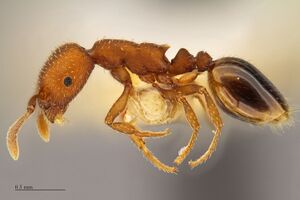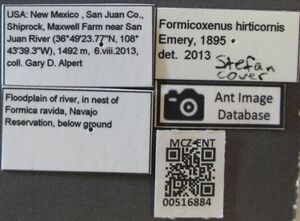Formicoxenus hirticornis
| Formicoxenus hirticornis | |
|---|---|

| |
| Scientific classification | |
| Kingdom: | Animalia |
| Phylum: | Arthropoda |
| Class: | Insecta |
| Order: | Hymenoptera |
| Family: | Formicidae |
| Subfamily: | Myrmicinae |
| Tribe: | Crematogastrini |
| Genus: | Formicoxenus |
| Species: | F. hirticornis |
| Binomial name | |
| Formicoxenus hirticornis (Emery, 1895) | |
| Synonyms | |
| |
This ant is a guest or xenobiont in the nests of Formica ciliata, Formica obscuripes, Formica ravida (based on MCZC specimens) and possibly Formica integroides.
| At a Glance | • Xenobiotic |
Identification
The eyes have several erect hairs and the clypeus of the worker is weakly depressed in the middle near the anterior border of the clypeus, and is without a medial carina, although several poorly developed lateral carinae are present. The propodeal spines are well developed, and thickened throughout. The anterior face of the petiole meets the dorsum in an angle, the posterior face is convex and rounded. The dorsum of the postpetiole is completely covered with punctures. The mesosoma has dense punctures. (Mackay and Mackay 2002)
Keys including this Species
Distribution
North and South Dakota, south to Colorado, west to California.
Latitudinal Distribution Pattern
Latitudinal Range: 53.941° to 34.156971°.
| North Temperate |
North Subtropical |
Tropical | South Subtropical |
South Temperate |
- Source: AntMaps
Distribution based on Regional Taxon Lists
Nearctic Region: Canada, United States (type locality).
Distribution based on AntMaps
Distribution based on AntWeb specimens
Check data from AntWeb
Countries Occupied
| Number of countries occupied by this species based on AntWiki Regional Taxon Lists. In general, fewer countries occupied indicates a narrower range, while more countries indicates a more widespread species. |

|
Estimated Abundance
| Relative abundance based on number of AntMaps records per species (this species within the purple bar). Fewer records (to the left) indicates a less abundant/encountered species while more records (to the right) indicates more abundant/encountered species. |

|
Habitat
Pine forest
Biology
Castes
Worker
   File:F hi File:F hi   
| |
| . | Owned by Museum of Comparative Zoology. |
Images from AntWeb
   
| |
| Worker. Specimen code casent0105759. Photographer April Nobile, uploaded by California Academy of Sciences. | Owned by USNM, Washington, DC, USA. |
Nomenclature
The following information is derived from Barry Bolton's Online Catalogue of the Ants of the World.
- hirticornis. Leptothorax (Leptothorax) hirticornis Emery, 1895c: 319 (w.) U.S.A. (South Dakota).
- Type-material: holotype worker.
- Type-locality: U.S.A.: South Dakota, Hill City (T. Ulke ?).
- [Note: Emery, 1895c: 319, originally gave the type-locality as “Washington D.C. (Pergande)”; however, Smith, M.R. 1939c: 179, cited “Hill City, S. Dak.(ota) (Titus Ulke ?)”, a change accepted by Francoeur, Loiselle & Buschinger, 1985: 382.]
- Type-depository: MSNG.
- Smith, M.R. 1939c: 176 (q. ergatoid); Snelling, R.R. 1965a: 18 (q. ergatoid m.).
- Combination in L. (Mychothorax): Ruzsky, 1905b: 622; Emery, 1924d: 262;
- combination in Mychothorax: Ruzsky, 1936: 96;
- combination in Formicoxenus: Buschinger, 1979a: 61.
- Status as species: Wheeler, W.M. 1903c: 224; Ruzsky, 1905b: 622; Wheeler, W.M. 1910g: 566; Wheeler, W.M. 1917a: 515; Emery, 1924d: 262; Kiseleva, 1925: 74; Ruzsky, 1936: 96; Smith, M.R. 1939c: 177 (redescription); Wheeler, G.C. & Wheeler, E.W. 1944: 248; Creighton, 1950a: 278; Smith, M.R. 1951a: 822; Smith, M.R. 1958c: 134; Snelling, R.R. 1965a: 16; Smith, M.R. 1967: 360; Yensen, et al. 1977: 183; Buschinger, 1979a: 61; Smith, D.R. 1979: 1397; Buschinger, 1981: 213; Allred, 1982: 484; Francoeur, Loiselle & Buschinger, 1985: 382 (redescription); Wheeler, G.C. & Wheeler, J. 1986g: 51 (in key) ; Wheeler, G.C., et al. 1994: 302; Bolton. 1995b: 207; Mackay & Mackay, 2002: 103; Coovert, 2005: 80.
- Senior synonym of formidolosus: Smith, M.R. 1939c: 177; Creighton, 1950a: 278; Smith, D.R. 1979: 1397; Francoeur, Loiselle & Buschinger, 1985: 382; Bolton, 1995b: 207.
- Distribution: U.S.A.
- formidolosus. Leptothorax (Mychothorax) hirticornis var. formidolosus Wheeler, W.M. 1915b: 415 (w.q.) U.S.A. (Colorado).
- Type-material: 5 syntype workers, 1 syntype ergatoid queen.
- Type-locality: U.S.A.: Colorado, Flagstaff Mt, nr Boulder (T.D.A. Cockerell).
- Type-depository: AMNH.
- Subspecies of hirticornis: Wheeler, W.M. 1917a: 515; Emery, 1924d: 262; Cole, 1936a: 36; Wheeler, G.C. & Wheeler, E.W. 1944: 248.
- Junior synonym of hirticornis: Smith, M.R. 1939c: 177; Creighton, 1950a: 278; Smith, D.R. 1979: 1397; Francoeur, Loiselle & Buschinger, 1985: 382; Bolton, 1995b: 207.
Unless otherwise noted the text for the remainder of this section is reported from the publication that includes the original description.
Description
Type Material
Wheeler (1903) - Washington D.C. (Pergande). Described from a single specimen in the collection of Prof. Emery.
References
- Buschinger, A. 1979a. Functional monogyny in the American guest ant Formicoxenus hirticornis (Emery) (= Leptothorax hirticornis), (Hym., Form.). Insectes Soc. 26: 61-68. (page 61, Combination in Formicoxenus)
- Carroll, T.M. 2011. The ants of Indiana (Hymenoptera: Formicidae). M.S. thesis, Purdue University.
- Emery, C. 1895d. Beiträge zur Kenntniss der nordamerikanischen Ameisenfauna. (Schluss). Zool. Jahrb. Abt. Syst. Geogr. Biol. Tiere 8: 257-360 (page 319, worker described)
- Emery, C. 1922c. Hymenoptera. Fam. Formicidae. Subfam. Myrmicinae. [part]. Genera Insectorum 174B: 95-206 (page 262, Combination in L. (Mychothorax))
- Francoeur, A.; Loiselle, R.; Buschinger, A. 1985. Biosystématique de la tribu Leptothoracini (Formicidae, Hymenoptera). 1. Le genre Formicoxenus dans la région holarctique. Nat. Can. (Qué.) 112: 343-403 (page 382, see also)
- Mackay, W.P. & Mackay, E.E. 2002. The Ants of New Mexico: 400 pp. Edwin Mellen Press, Lewiston, N.Y.
- Ruzsky, M. 1936. Ants of the Transbaikal region. Tr. Biol. Nauchn.-Issled. Inst. Tomsk. Gos. Univ. 2: 89-97 (page 96, Combination in Mychothorax)
- Seifert, B. 2023. Two new species of Formicoxenus Mayr 1855 and Leptothorax Mayr 1855 from Tibet (Hymenoptera: Formicidae). Soil Organisms 95(2), 129-142 (doi:10.25674/SO95ISS2ID315).
- Smith, M. R. 1939c. Notes on Leptothorax (Mychothorax) hirticornis Emery, and description of a related new species (Formicidae). Proc. Entomol. Soc. Wash. 41: 176-180. (page 176, queen ergatoid described; page 177, senior synonym of formidolosus)
- Snelling, R. R. 1965a. Studies on California ants. 1. Leptothorax hirticornis Emery, a new host and descriptions of the female and ergatoid male (Hymenoptera: Formicidae). Bull. South. Calif. Acad. Sci. 64: 16-21.(page 18, queen, male ergatoid described)
- Wheeler, W. M. 1903d. A revision of the North American ants of the genus Leptothorax Mayr. Proc. Acad. Nat. Sci. Phila. 55: 215-260 (page 224, see also)
References based on Global Ant Biodiversity Informatics
- Allred D. M. 1982. Ants of Utah. The Great Basin Naturalist 42: 415-511.
- Allred, D.M. 1982. The ants of Utah. Great Basin Naturalist 42:415-511.
- Carroll T. M. 2011. The ants of Indiana (Hymenoptera: Formicidae). Master's Thesis Purdue university, 385 pages.
- Clark W. H., and P. E. Blom. 2007. Annotated Checklist of the Ants on the Idaho National Laboratory (Hymenoptera: Formicidae). Sociobiology 49(2): 1-117.
- Cole A. C., Jr. 1942. The ants of Utah. American Midland Naturalist 28: 358-388.
- Cole, A.C. 1936. An annotated list of the ants of Idaho (Hymenoptera; Formicidae). Canadian Entomologist 68(2):34-39
- Glasier J. R. N., S. E. Nielsen, J. Acorn, and J. Pinzon. 2019. Boreal sand hills are areas of high diversity for Boreal ants (Hymenoptera: Formicidae). Diversity 11, 22; doi:10.3390/d11020022.
- Glasier J. R. N., S. Nielsen, J. H. Acorn, L. H. Borysenko, and T. Radtke. 2016. A checklist of ants (Hymenoptera: Formicidae) of Saskatchewan. The Canadian Field-Naturalist 130(1): 40-48.
- Gregg, R.T. 1963. The Ants of Colorado.
- Kannowski P. B. 1956. The ants of Ramsey County, North Dakota. American Midland Naturalist 56(1): 168-185.
- Mackay, W., and E. Mackay. The ants of New Mexico. The Edwin Mellen Press, 2002.
- Smith M. R. 1952. On the collection of ants made by Titus Ulke in the Black Hills of South Dakota in the early nineties. Journal of the New York Entomological Society 60: 55-63.
- Snelling R. R. 1965. Studies on California ants. 1. Leptothorax hirticornis Emery, a new host and descriptions of the female and ergatoid male (Hymenoptera: Formicidae). Bulletin of the Southern California Academy of Sciences 64: 16-21.
- Talbot M. 1976. A list of the ants (Hymenoptera: Formicidae) of the Edwin S. George Reserve, Livingston County, Michigan. Great Lakes Entomologist 8: 245-246.
- Wheeler G. C., J. N. Wheeler, and P. B. Kannowski. 1994. Checklist of the ants of Michigan (Hymenoptera: Formicidae). The Great Lakes Entomologist 26(4): 297-310
- Wheeler G. C., and E. W. Wheeler. 1944. Ants of North Dakota. North Dakota Historical Quarterly 11:231-271.
- Wheeler G. C., and J. Wheeler. 1987. A Checklist of the Ants of South Dakota. Prairie Nat. 19(3): 199-208.
- Wheeler W. M. 1903. A revision of the North American ants of the genus Leptothorax Mayr. Proceedings of the Academy of Natural Sciences of Philadelphia. 55: 215-260.
- Wheeler W. M. 1917. The mountain ants of western North America. Proceedings of the American Academy of Arts and Sciences 52: 457-569.
- Wheeler, G.C., J. Wheeler and P.B. Kannowski. 1994. CHECKLIST OF THE ANTS OF MICHIGAN (HYMENOPTERA: FORMICIDAE). Great Lakes Entomologist 26:1:297-310
- Yensen, N.P., W.H. Clark and A. Francoeur. 1977. A checklist of Idaho Ants. The Pan-Pacific Entomologist 53:181-187
- Pages using DynamicPageList3 parser function
- Ant Associate
- Host of Formica ciliata
- Host of Formica obscuripes
- Host of Formica ravida
- Host of Formica integroides
- Xenobiotic
- North temperate
- North subtropical
- Pages with broken file links
- Species
- Extant species
- Formicidae
- Myrmicinae
- Crematogastrini
- Formicoxenus
- Formicoxenus hirticornis
- Myrmicinae species
- Crematogastrini species
- Formicoxenus species
- Need Body Text

